Bulletin – June 2017 Australian Economy Houses and Apartments in Australia
- Download 510KB
Abstract
Apartments have become an important part of the housing mix in Australia. This has several implications for assessments of residential activity. The lag from a change in monetary policy to the effect on residential activity might increase, because it takes longer to build large apartment buildings than detached houses. Apartment developments use different construction materials and labour, and may face different cost pressures to the detached house segment. They also face different supply-side constraints.
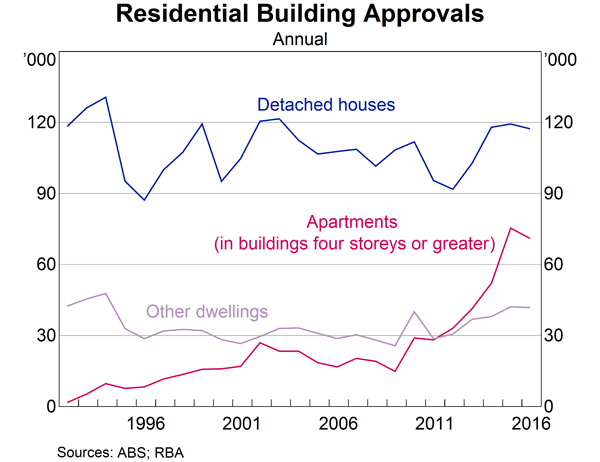
Introduction
The composition of homes being built in Australia has changed substantially over the past decade. The number of apartments constructed each year has tripled since 2009 and, last year, apartments accounted for around one-third of residential building approvals (Graph 1). In contrast, the volume of detached houses built last year was roughly in line with the average over the past three decades. The shift towards higher density housing is bringing Australia more into line with international norms because Australia's existing housing stock is heavily concentrated in detached houses and its cities have a relatively low density compared with those in other industrialised economies (RBA 2014a). The increase in apartment construction has driven new housing construction to a historically high level and made a strong contribution to economic growth (Graph 2).
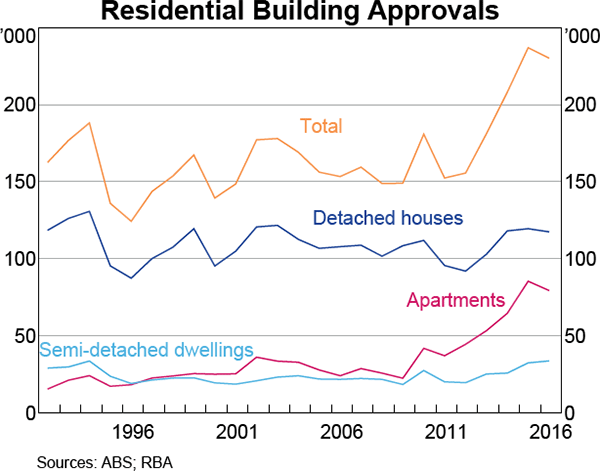
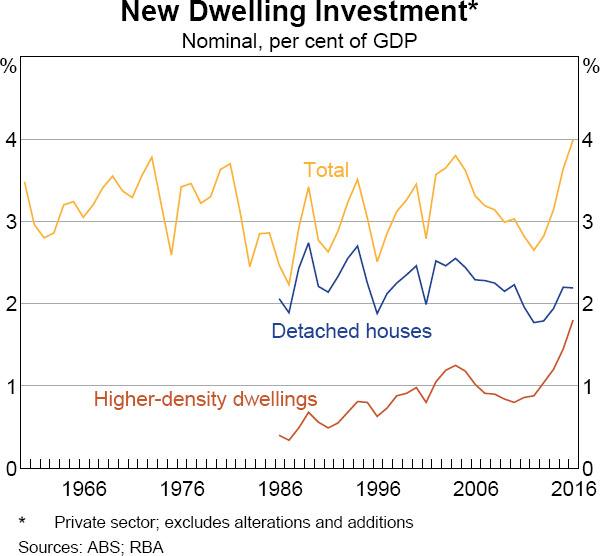
Differences between the construction processes for apartments and detached houses are important to consider in the analysis of the housing sector and related macroeconomic variables. This includes the pipeline of dwelling investment, the measurement of housing turnover and price inflation. Although residential construction accounts for a relatively small share of economic activity, it has a large effect on overall developments in the Australian economy. This is because new dwelling investment is volatile and it has strong links with spending on household goods. In addition, dwelling investment is relatively sensitive to changes in interest rates compared with other parts of the economy. As such, the longer development timelines for apartment projects have implications for the lags between changes in interest rates and activity.
The relative importance of supply-side issues, such as land availability and planning processes, also differs between houses and apartments. In addition, the two types of dwellings use different materials and supply chains which have implications for our assessment of cost pressures and final prices (which ultimately feed through to the consumer price index (CPI)).
Dwelling Types and Recent Activity
Dwellings approved for construction in Australia can be broken down into two broad categories (as defined by the Australian Bureau of Statistics (ABS)): detached houses, which accounted for about three-quarters of the dwelling stock in the 2011 Census; and higher-density dwellings. The latter can be further split into apartments (defined as ‘flats, units or apartments’), which accounted for about 15 per cent of the stock of dwellings in 2011, and ‘semi-detached’ dwellings (such as townhouses, terraces and semi-detached houses), which accounted for 10 per cent.[1] ‘High-rise’ apartments have accounted for much of the increase in residential building approvals since the start of the decade (‘high-rise’ is defined as projects that are four storeys or greater; Graph 3).[2] Approvals for detached houses have increased from their trough in 2012 to be around their average of the past three decades.
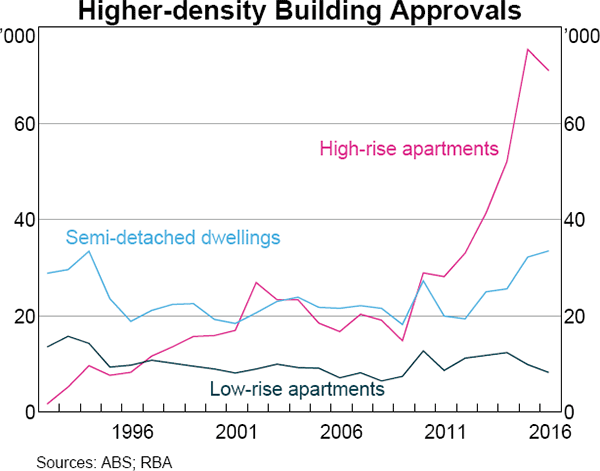
Building approvals for apartments have been highly concentrated in large cities – the capital cities accounted for 90 per cent of apartment approvals in 2016, of which most were in Sydney, Melbourne and Brisbane (Graph 4). By comparison, approvals for detached houses have been more geographically dispersed, with around two-thirds of approvals last year located in the capitals, and less than half in the eastern seaboard capitals. In the major cities, apartments have been mostly constructed in inner (and, to a lesser extent, middle) suburbs, which are well connected with employment centres and amenities, though the concentration has varied somewhat by city (Graph 5). In contrast, new house construction has largely been located in fringe or outer suburbs of cities where land is more readily available.
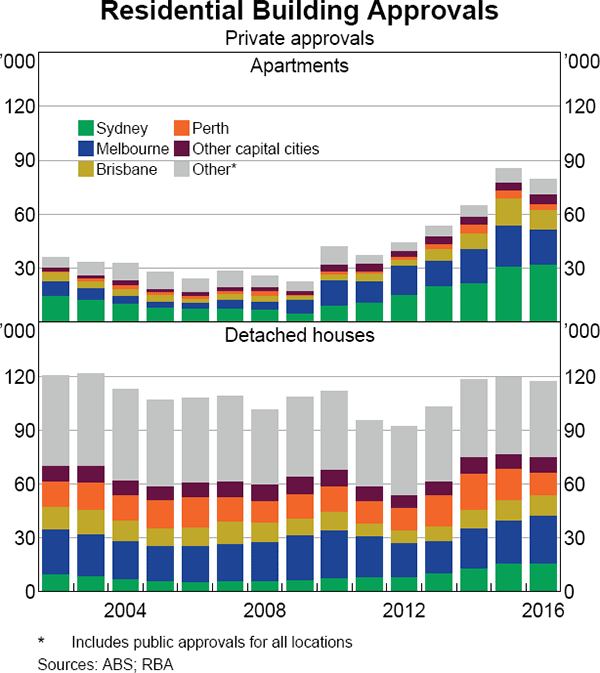
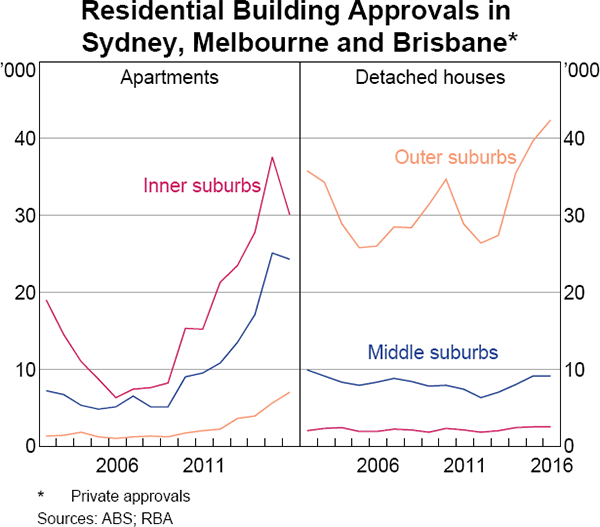
Dwelling Demand and Buyers
Determinants of demand for different types of dwellings include affordability, location and buyer types and preferences, alongside macroeconomic determinants such as population and employment growth. Apartments are typically much more affordable than houses. The median price of apartments is around 30 per cent lower than that for houses, in part because apartments are typically smaller but also because apartments use land more intensively (Graph 6). In recent years, lower relative prices have supported the demand for apartments as land supply constraints in the eastern cities have led to significant land price inflation (the supply of land for detached houses is ultimately more limited relative to that for higher-density dwellings), most notably in Sydney.
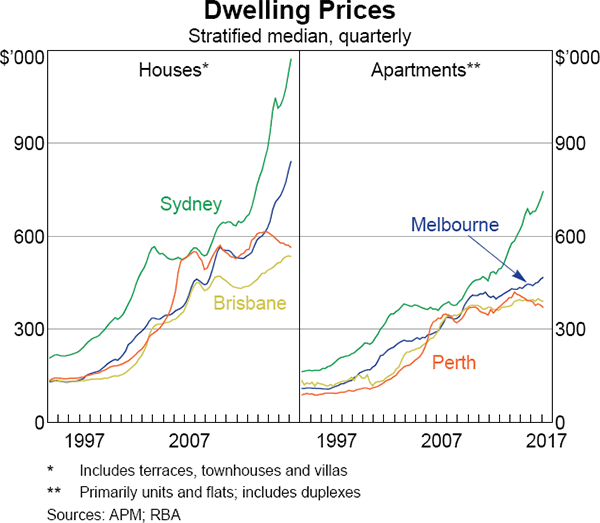
Location and lifestyle preferences also influence buyers' decisions. New apartments are generally located in established suburbs close to employment and services, while new houses are often built in greenfield areas that may be awaiting infrastructure and other amenities. The desire to reside close to major employment centres and transport links is likely to have increased in larger cities where travel times have lengthened. Demographic factors and household formation also matter – larger households are more likely to want larger dwellings, such as houses, while smaller households, such as single adults and older ‘downsizers’, may prefer apartments.
There are three broad types of buyers for new dwellings – owner-occupiers, domestic investors and foreign buyers (i.e. non-residents). The prominence of these buyer types differs for houses and apartments, and can also vary by location (particularly for apartments) (Shoory 2016).
Information from the Bank's liaison program suggests that, in recent years, domestic investors and foreign buyers have generally been much more prominent in purchasing new apartments than they have been for new houses.[3] Demand from these buyers has partly driven the shift towards apartment construction, and is likely to have led to an increase in the net supply in rental apartments. Rental yields for apartments are higher than those for houses (Graph 7). Foreign buyers are also likely to be more familiar with apartment-style living, given many international cities have a high share of apartments, and are likely to prefer locations in more convenient inner-city areas or near existing communities. In contrast, owner-occupiers reportedly account for the majority of new detached home purchases, partly reflecting demographic factors and household size. The net effect of these purchases on the housing supply will depend on the location and size of the existing property the purchaser is moving from and whether there is a change in the rate of household formation.
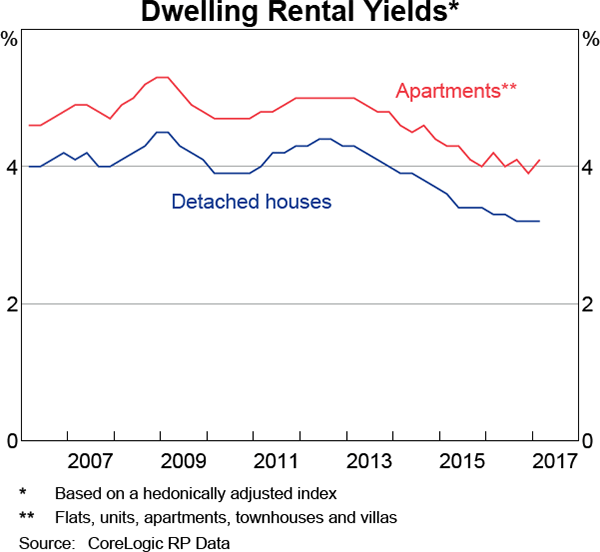
Development and Construction
Development and construction timelines for both detached houses and apartments are long and variable, and the time taken at each stage can vary greatly. These differences are important to consider when assessing market conditions, including changes in supply and demand, and the response to changes in interest rates.
Even before construction commences, the time spent developing apartment projects is often lengthy. Once a developer has purchased a site, it may take several years until construction commences (Table 1). Securing a development approval (DA) may take several months or years, particularly if planning issues are encountered. Evidence from the Bank's liaison program suggests that most apartment projects require the majority of apartments to be pre-sold off the plan for the developer to secure finance. Marketing to prospective buyers may take months or even longer than a year, depending on the characteristics of the project. Builders are typically secured by developers via a tender process, and only once all these arrangements are in place will building permits be obtained. This is the stage at which the ABS typically records a building approval. Given that most of the development time occurs before a building approval is recorded, building approvals data do not provide a read on how the earlier stages of the development pipeline may be evolving.
Developing land and building detached houses are often separate processes. Greenfield land estates are often developed by specialists who then sell to individuals (who source their own builder) or to builders (who sell house and land packages to households).[4] The timelines for developing housing on greenfield land can vary significantly, particularly if rezoning is required (Table 2). Once land has been developed and registered to an owner, construction of a house may commence quickly. For detached houses in established/existing suburbs, referred to as ‘infill housing’, the overall planning process is typically shorter than in greenfield areas (though it may be extended if characteristics of the build are unusual relative to the local area).
| Stage 1 | Stage 2 | Stage 3 | Stage 4 | Stage 5 | Stage 6 |
|---|---|---|---|---|---|
| Site selection, design project and prepare development application | Authority assesses development application for approval (may involve community input, appeals, amendments and zoning changes) | Market apartments. Secure pre-sales, builder and project finance | Receive permit to proceed with construction (building approval generally recorded by ABS) | Construction (dwelling investment recorded by the ABS) | Settlement (owners or tenants can occupy apartments) |
|
Source: RBA business liaison |
|||||
It generally takes longer to construct apartment buildings than detached houses due to their larger scale. Liaison with industry contacts suggests that construction of a large high-rise project takes 2–3 years, though this can increase to 4–5 years for very large towers, compared to 6–9 months for most detached houses.[5] Additions to the housing supply from apartment construction are also lumpier, with the largest projects comprising more than 1,000 dwellings.
Implications of development timelines
The longer and lumpier apartment project construction timelines have a range of implications for forecasting dwelling investment activity, and also understanding the contribution of dwelling investment to economic activity. In the current cycle, the shift in housing composition towards apartments, and more specifically towards high-rise apartments, has led to an increase in the average construction time for dwellings. Historically, dwelling investment in Australia has been very responsive to changes in monetary policy. Although it is difficult to formally test the relationship between interest rates and apartment activity with only a partly completed cycle, it is likely that the new apartment activity stemming from a change in interest rates will, on average, flow through to the economy over a much longer time period than for detached houses.
| Stage 1 | Stage 2 | Stage 3 | Stage 4 | Stage 5 | Stage 6 |
|---|---|---|---|---|---|
| Land development | House construction | ||||
| Site selection and rezoning to residential (if required) | Development plan and approval (includes plans for roads, utilities and community services) | Sub-divide land and commence civil infrastructure works. Marketing and sales of individual lots may commence | Issue titles for individual lots/ registered owners (once development completed) | Owner of titled land appoints builder, acquires development approval and construction commences | Settlement of house purchase (or sale of completed house if the developer was also the builder) |
|
Source: RBA business liaison |
|||||
The increased length of construction in turn affects the interpretation of the pipeline as a leading indicator of dwelling investment (Graph 8). An approved apartment typically takes at least three times as long to complete as a detached house, which means that the pipeline of work to be done provides information on dwelling investment further into the future. The shift in composition of approvals towards apartments, if sustained, would result in a larger pipeline of work to be done. The longer lag between the decision to build an apartment and its completion means that the impact of changes in the supply of housing on other housing market indicators, including prices, rents and vacancy rates, may be less predictable than in the past (RBA 2017).
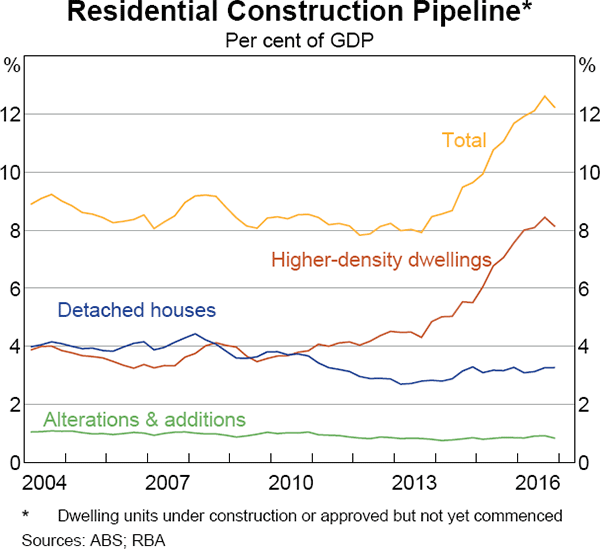
There are also other considerations as the length of time between the decision to build (for developers) or buy (for individuals) changes. For example, changes in financing conditions will take longer to flow through to construction activity. Furthermore, there is more time during which conditions in the underlying economy or personal circumstances can change between the off-the-plan sale of an apartment and its completion. As such, the full impact of changes in policies that affect demand and supply may not be fully realised by the dwelling sector for several years.[6]
Housing turnover appears to have been unusually weak in recent years compared with the strength in a range of other housing market indicators. It is likely that part of the recent weakness in the measured housing turnover rate could be due to measurement issues arising from the increased share of apartments in new housing construction (Leal et al, 2017). As the majority of new apartments are purchased off the plan, well before construction has commenced, sales can have settlement lags of around two or three years, or longer. However, data providers have limited information about these sales until settlement, implying that contract-dated measures of housing turnover are likely to be understating actual turnover in recent years. Elevated levels of new apartment construction would be expected to increase the degree of this understatement.
Supply-side Issues
There are several factors that have affected how the supply of new housing has responded to price movements over recent years.[7] These include the acquisition and development of land on which construction will take place, providing infrastructure to service that land (if necessary), and the planning and approvals process (including land-use zoning, the DA and building permits).
The extent to which supply-side factors influence the responsiveness of construction of new dwellings differs for houses and apartments. Land developers and home builders in the Bank's liaison program generally report that the greatest impediment to the supply of new houses is the availability of land that is serviced with necessary infrastructure. This reflects a combination of geographic constraints (which limit the raw quantity of land available for development), fragmented ownership of the land that has been identified for potential development, and the provision and financing of infrastructure to service that land (including water and sewerage systems, public transport and roads). The latter is particularly relevant for the construction of new houses because these dwellings are usually located in new suburbs (i.e. greenfield areas).
The planning and approval process is generally cited as a significant impediment to new apartment construction by developers in the Bank's liaison program. This includes the zoning restrictions attached to land in established suburbs, such as density and height restrictions and permissible uses of that land, and the time and complexity associated with obtaining a DA. The availability of suitable land (‘sites’) is also a factor for new apartment projects, though geographic limitations and infrastructure provision are generally less binding constraints. This is because these dwellings use land more intensively than houses, achieving much greater density. In addition, those sites are most commonly located in established suburbs that are already connected with necessary infrastructure (though upgrading infrastructure and amenities to cope with increased population density is a necessary consideration for the relevant authorities).[8]
The impact of these supply issues also varies by location. For instance, land supply constraints for houses have been particularly acute in Sydney in recent years; geographic constraints and strong demand for land have contributed to substantial price increases and lengthy development lags. For apartments, the time and complexity of the DA approval process reportedly differs both across and within cities, and influences the number and scale of apartment projects, and the speed with which supply responds to demand. The Bank's liaison with industry participants suggests that a more centralised framework (such as when the state government planning department assesses the DA) generally facilitates a quicker response compared with situations where local councils make the decision (Shoory 2016).
Input Costs and Dwelling Prices
There are differences in the labour and material inputs used in the construction of houses compared with apartments. These differences and the composition of the new dwellings being constructed have potentially important implications for assessing cost and price inflation in the economy.
The Bank's liaison with industry participants suggests that labour and materials each account for around half the cost of construction for both apartments and houses. Nevertheless, there are some differences in the types of labour and materials used. For instance, apartment construction typically involves a higher proportion of steel, concrete and glass relative to detached houses, while the latter requires a larger share of timber and bricks. High-rise structures also require more complex components than detached houses, such as elevators and reinforced windows. Site access is often more difficult and costly for apartment projects.
The labour requirements also differ, including in the trades and professions required for construction, and the organisation of the labour (particularly in the larger cities). Bricklayers, for example, are commonly required in building houses but not for high-rise apartment projects.[9] A very large share of labour costs for detached houses is accounted for by subcontractors who are often sole traders. By contrast, labour for high-rise apartment and office construction sites, at least in the eastern states, tends to be attached to large companies with significant workforces.
Trends in construction costs over time have differed (sometimes considerably) for houses and apartments, in part due to differences in the construction supply chain. For much of the past five years, the cost of building detached houses has grown more quickly than the cost of higher-density dwellings (including apartments) (Graph 9). The slower growth in apartment building costs could reflect a range of factors including larger productivity improvements and spare capacity in the construction of office property, which uses similar materials and labour inputs to apartments. Earlier in the 2000s, apartment construction costs were more volatile than detached costs.
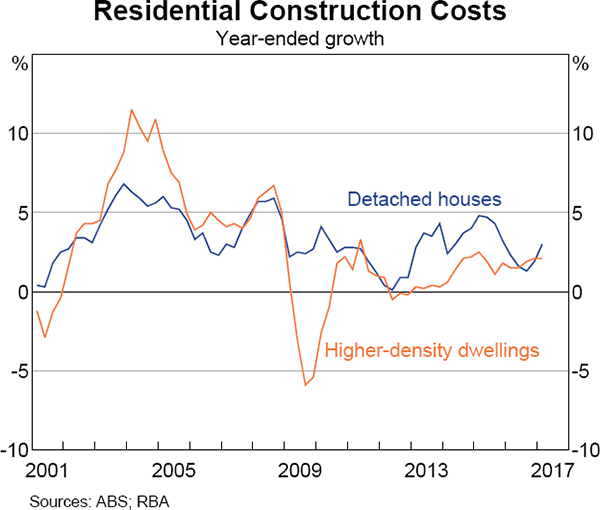
These cost and price dynamics are particularly relevant for consumer price inflation, given the large weight (9 per cent) for ‘new dwelling costs’ in the CPI. New dwelling costs were measured as the cost of construction for a new detached house until December quarter 2016, but from the March quarter 2017, the CPI also included costs for apartments in the new dwelling cost series (ABS 2017a). This change in measurement is an important consideration, given the historical differences in cost growth for these dwelling types and the increased share of new dwellings accounted for by apartments in recent years (apartments account for about one-fifth of new dwelling costs). There can also be substantial differences in the rate of apartment cost inflation by city (Graph 10). Nevertheless, the near-term effect on the national index is expected to be limited as the current rate of inflation in each component is similar.
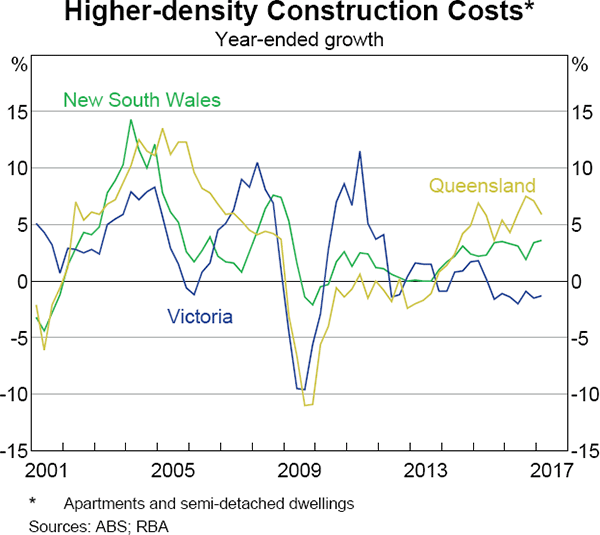
Conclusion
The growing share of apartments in Australia's housing mix has a wide range of implications for the analysis of dwelling investment, housing markets and price inflation. The response of the housing sector to changes in interest rates, as well as government policies, is also likely to have changed. In particular, the longer and lumpier construction timelines for apartments mean the full influence of policy changes may take many years to be realised. The increase in apartment construction activity is a relatively recent development and so the understanding of these implications may evolve over time, particularly after a full cycle of activity is observed.
Box A
Housing and the Consumer Price Index[1]
Housing plays an important role in the calculation of the CPI. ABS estimates suggest that more than one-fifth of all spending by Australian households is directed towards housing, and this is reflected in the weight of housing in the CPI. The purchase price of new owner-occupied dwellings has an effective weight of around 9 per cent in the CPI, while rent has a weight of around 7 per cent. These are the largest expenditure items in the CPI basket. Maintenance and property charges, and utilities (including electricity, gas and water) account for a further 8 per cent of the basket. Importantly, the CPI excludes land, as land is treated as investment not consumption.
Owner-occupier housing is difficult to include in consumer price indexes. The methods used to measure these prices differ depending on the conceptual approach used, though none of the standard conceptual approaches to measuring price indexes include the cost of existing dwellings. The CPI is primarily used as a macroeconomic indicator to monitor and evaluate levels of inflation in the Australian economy (ABS 2017b). The ABS has stated that the most appropriate way to measure household inflation is to use the ‘acquisitions’ approach. The RBA has previously stated it ‘strongly supported’ the acquisition approach used by the ABS, consistent with the CPI being a general measure of household inflation (RBA 2010). This approach defines the basket of goods and services as consisting of all those consumer goods and services actually acquired by households during the base period.
The ABS also publishes a range of indices designed to measure changes in living costs of different groups in the community. These ‘living cost’ indices are calculated for selected representative households including employees, pensioners and self-funded retirees. These indices are calculated using the ‘outlays’ approach, which measures out-of-pocket expenses. Specifically, it defines the consumption basket in terms of the actual amounts paid out by households during the base period to gain access to consumer goods and services. ‘Cost-of-use’ is the third main conceptual measurement approach, based on the basket of consumer goods and services actually consumed in the base period, regardless of when they were acquired or paid for.
The practical differences between the acquisitions and outlays approaches are limited for most areas of household consumption. However, there are important differences in the measurement of owner-occupied housing costs, particularly relating to the inclusion of interest charges. The acquisitions approach, used for the CPI, measures owner-occupier housing costs as the net acquisition of new dwellings excluding land. This includes both the cost of detached and attached dwellings such as apartments (as of the March quarter 2017). This assumes the cost of the structure is the consumable item, while the cost of land is investment.
Under the outlays approach, used for the ABS living cost indices, owner-occupier housing costs are measured as mortgage interest charges, not the cost of constructing a dwelling. Mortgage charges will be affected by the prices of existing dwellings as they affect the current level of mortgage debt, but will also be affected by mortgage interest rates. The ABS estimates that the rise in dwelling prices over the past decade has been more than offset by the fall in interest rates, so mortgage charges have fallen (Graph A1). The inclusion of interest charges in the CPI is problematic for both conceptual and practical reasons. The main conceptual issue is that interest charges represent a relative price (that of consumption in the future as opposed to the present), rather than the current price of a good or service. The main practical problem is that the interest charges as measured tend to distort the signal offered by the CPI of inflationary trends, by incorporating the policy responses to those trends.
Under the ‘cost-of-use’ approach, statistical agencies often assume that the cost of housing is equal to the rent that the household would receive for that dwelling, so they measure it as an ‘imputed rent’. The use of imputed rents is fairly common internationally. Rent inflation in the CPI provides a rough indication of what this might look like in the Australian context. Rent inflation is around levels last seen in the mid 1990s, with relatively weak outcomes across most cities and strong deflation recently in Perth (Graph A2). The increase in supply of new housing in some cities is putting downward pressure on rents.
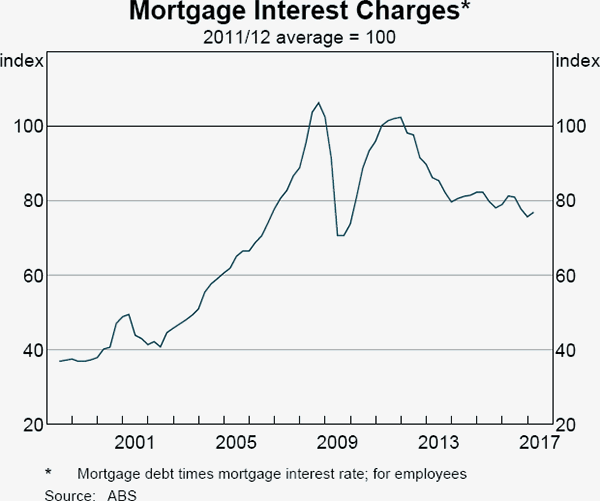
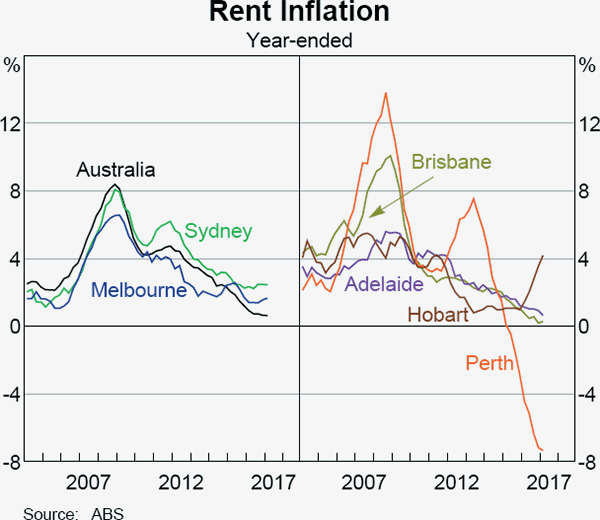
Footnotes
The authors are from Economic Analysis Department. [*]
This level of disaggregation of building type is not available for most other indicators of residential activity, including other ABS data releases (such as building work done), and housing price indicators compiled by the ABS and other sources. [1]
The ABS building approvals data for apartments in buildings that are four storeys or greater are unable to be disaggregated any further. [2]
Foreign individuals and temporary residents are permitted to purchase any new dwelling. Temporary residents with visas that allow them to stay in Australia for a continuous period of more than 12 months (such as some foreign students and people on skilled business visas) are permitted to purchase one established home provided it is used as their principal place of residence while in Australia and is sold once vacated. [3]
Some land developers are also builders. A limited volume of speculative house and land development also takes place, where a builder will construct a house and then sell it on the market. [4]
ABS (2016) suggests that in recent years the average completion time is around 6 quarters for apartments (covering projects of all sizes) and 2 quarters for detached houses. [5]
For example, buyers of off-the-plan apartments may seek a pre-approval for a loan. The long lag to the completion of construction increases the risk that the lender may decide to reduce the amount they are willing to lend at final approval, thereby increasing the risk that the buyer is no longer able to complete the transaction. [6]
See Hsieh, Norman and Orsmond (2012) for a detailed description of supply factors in the housing sector. [7]
More recently, a tightening in the availability of finance has been cited as another significant impediment to developing apartment projects, particularly in markets where banks are concerned about the potential for oversupply. [8]
There are some similarities in labour, most notably in the ‘finishing’ components of construction such as internal painting, tiling and appliance installation. [9]
Footnote Box A
This box draws on material from ABS (2017b). The authors would also like to thank Martin McCarthy (Economic Analysis Department) for his contribution. [1]
References
ABS (Australian Bureau of Statistics) (2016), ‘Average Dwelling Completion Times’, Feature Article in ‘Building Activity, Australia, Jun 2016’, ABS Cat No 8752.0.
ABS (2017a), ‘Measuring Price Change of Attached Dwellings in the CPI’, Feature Article in ‘Consumer Price Index, Australia, Dec 2016’, ABS Cat No 6401.0, pp 11–16.
ABS (2017b), ‘What Role Does Housing Play in the Consumer Price Index and Selected Living Cost Indexes?’, Feature Article in ‘Selected Living Cost Indexes, Australia, Mar 2017, ABS Cat No 6467.0.
Hsieh W, D Norman and D Orsmond (2012), ‘Supply-side Issues in the Housing Sector’, RBA Bulletin, September, pp 11–19.
Leal H, S Parsons, G White and A Zurawski (2017), ‘Housing Market Turnover’, RBA Bulletin, March, pp 21–30.
RBA (Reserve Bank of Australia) (2010), ‘Submission to the 16th Series Review of the Consumer Price Index’, Submission to the ABS 16th Series Review of the Consumer Price Index, 17 March.
RBA (2014a), ‘The RBA's Business Liaison Program’, RBA Bulletin, September, pp 1–5.
RBA (2014b), ‘Submission to the Inquiry into Affordable Housing’, Submission to the Senate Economics References Committee Inquiry into Affordable Housing, 14 February.
RBA (2016), ‘Box B: Chinese Demand for Australian Property’, Financial Stability Review, April, pp 30–32.
RBA (2017), ‘Box A: The Pipeline of Residential Dwelling Work’, Statement on Monetary Policy, February, pp 36–37.
Shoory M (2016), ‘The Growth of Apartment Construction in Australia’, RBA Bulletin, June, pp 19–26.